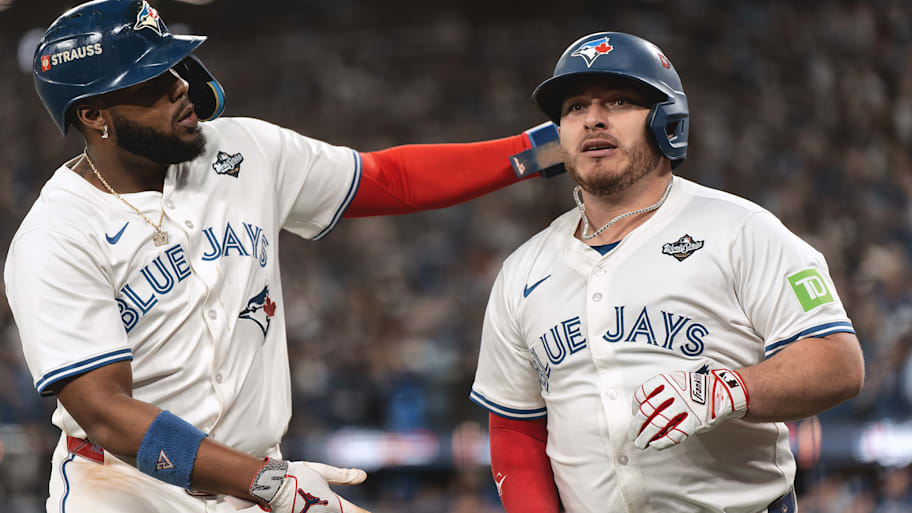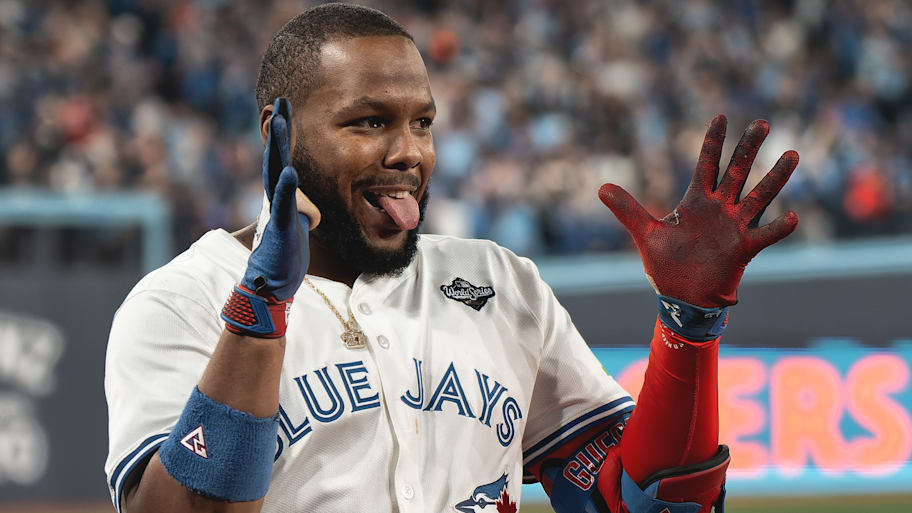TORONTO — The Toronto Blue Jays are out to change baseball, one stinking, annoying, pesky, skin-crawling, chalkboard-scratching, stone-in-my-shoe, please-make-it-stop foul ball at a time.
“That’s our goal,” says Toronto infielder Isaih Kiner-Falefa. “To change baseball. We’re doing something that’s not taught anymore. We’re trying to bring baseball back to … well, baseball.”
It is a lofty goal that is three wins within reach after such a pestiferous 11–4 World Series Game 1 victory Friday over Los Angeles that after it, Dodgers pitchers should have been reaching for calamine lotion instead of ice.
After five seasons in which only a top-four home run team has won the World Series, Toronto (11th in homers, first in lowest strikeout rate) wants to turn the baseball world upside down, if not back to the 1970s.
The Blue Jays scored their 11 runs on 14 hits, including three homers, while striking out just four times. Talk about retro. They turned the baseball clock all the way back to 1978, the time of bell bottoms, love beads and the only World Series game in which a team had so many runs, hits and homers with only four strikeouts: an 11–5 win for the Dodgers over the Yankees in 1978 World Series Game 3.
So artful was Toronto it had nearly as many hits as swings and misses (15). The Blue Jays fouled off 39 pitches, 19 of them with two strikes. Their turn at bat in the sixth inning played out like one of those floor-borne domino cascades in which the tiles topple over one-by-one in serpentine style; there was artistry in a chain reaction that seemed to go on forever.
Twelve batters against three pitchers in that inning saw 44 pitches, including 15 pitches with two strikes without a swing and miss, fouled 12 pitches, put nine balls in play, drew two walks, took a hit by pitch and hit two homers.
“The epitome of how we play baseball,” infielder Ernie Clement calls it. “That inning is pretty much all we do as a team, as a group.”
The Dodgers brought to the series the best swing-and-miss pitching staff in the National League, especially Game 1 starter Blake Snell, who had a 50% whiff rate in three postseason starts this year. Now they know they have a fight on their hands with the toughest team to put away in baseball, whether that refers to when the Jays trail (they scored 11 unanswered runs after falling behind 2–0) or when they have two strikes.
“He had his stuff tonight,” Kiner-Falefa says. “We did a good job of getting into their bullpen. The moment he came out of the game we took advantage. We wore him down as much as we could. And it’s tough to wear him down when he’s in the zone as much as he was.”

Blue Jays’ preparation paying dividends
What is happening in this war of resistance in Canada is a synchronicity of hitting philosophy and sports performance experts on both the athletic training and strength training sides. Everything is connected. Everything is coordinated by first-year hitting coach David Popkins, 35, and assistant hitting coaches Lou Iannotti, 32, and Hunter Mense, 41, none of whom played a day in the big leagues but have plenty of experience playing independent ball.
Each day, for instance, the team posts a readout of each player’s bat speed from the previous night’s game.
“So, if a guy’s bat speeds are down, then he’ll hit the weight room,” Kiner-Falefa says. “Or I'll back off on the field [pregame work]. And if my bat speed’s down again, then I need to go in and get in the weight room and get with the hitting coaches and make the mechanical adjustment to get the bat speed back up.”
Mostly all the Blue Jays also wear Catapult vests that track daily energy expenditure.
“We wear those Catapults and they’d be like, ‘Alright, you’re working out too much,’” Kiner-Falefa says. “It was the first time where I saw it where they helped you get ready for the game. It wasn't just like tracking how much you did. They’re tracking your [swing] rotation to see, ‘Hey, my rotation's 50% low.’ It’s very skill specific.”
Sometimes the fix is physical.
“It could just be as simple as something’s locked up in your body,” Kiner-Falefa says. “Okay, then you go in the training room. And this is the best health facility, weight room and training staff I have ever seen.”
In recent years the Blue Jays so meticulously overhauled their home clubhouse facilities—which stretch from home plate to the leftfield foul pole—that they modeled their recovery room after a Four Seasons resort, complete with sauna, hot and cold tubs and a rock waterfall that spills over a giant Blue Jays logo in a stone wall.
“The hitting coaches will send me to the weight room, like if I’m not hinging properly,” Kiner-Falefa says. “The weight training coaches will send me to the training room and say, ‘You're not able to hinge,’ or ‘do your RDL [Roman deadlift] right. You gotta get worked on.’ They are so in sync that last year when I was here, I had my best offensive year, and I felt like it had a lot to do with weight training coaches and training staff.”
The hitting coaches encourage finding different ways to beat opponents, not just the modern way of selling out for home runs and accepting strikeouts as the tariff. Each day, in addition to posting daily bat speeds, Popkins and the hitting group keep track of an internal points system, which is used in the minor league system as well.
“So, it’s things like balls-in-play points,” Clement says, “and then it’s based on your swing decisions. Like, ‘Did you swing at strikes?’ And then it’s like, ‘How likely was the swing that you had to be at least a base hit or have damage?’
“We did a lot of it in Triple A, not so much here, but I like to kind of check the numbers and see where we're at. I mean, it definitely reinforces the idea of what you're trying to do, right?”
Popkins’s philosophy also adheres to a tenet that is anathema to most teams: ground balls are okay.
“Other teams I played on were more about home runs,” says Kiner-Falefa, a former Yankee. “It’s just, ‘We're going to beat you with home runs.’ But I feel like this team, sometimes it’s better to put a ball on the ground—in certain situations. Where I feel like I could get a hit that way. So, the hitting coaches do a great job of letting you go out there and be like, ‘It’s okay to hit the ball on the ground. Just hit it hard.’
“As opposed to in New York, it’s all pull-side in the air. And if you don’t, if you hit the ball on the ground, you’re in trouble. So here it’s like, we don’t care about the results—I mean, we care—but we care about how hard we hit the ball and putting the ball in play and swinging at good pitches.”
The way Toronto teaches two-strike hitting is fascinating in its posture-based approach.
“Our hitting coaches do a great job of making us be athletic,” Kiner-Falefa says. “They try to make everybody athletic so that when you get to two strikes you’re not breaking down and you’re not stiff. They want us to get our swings off but at the same time it’s not being stiff. It’s just fighting and there’s a [priority on] competing out there and there is pride in putting the ball in play, which is rare these days.”
The Blue Jays had four walks to go with their four strikeouts. It had been 20 years, going back to the 2005 White Sox, since a team opened the World Series with four or fewer strikeouts and just as many walks.
The key storyline at the onset of this series was the matchup between the red-hot swing-and-miss pitching staff of the Dodgers against the red-hot, put-the-ball-in-play hitters of the Blue Jays. Good pitching, as the adage goes, is supposed to win those battles. But Game 1 set up the possibility that maybe it’s good hitting’s turn to win. Maybe putting the ball in play is the postmodern way forward. Maybe the Blue Jays are the future of baseball—or at least for the next week.
More MLB on Sports Illustrated
This article was originally published on www.si.com as Blue Jays’ World Series Game 1 Victory Is a Win for an Old-School Approach.
